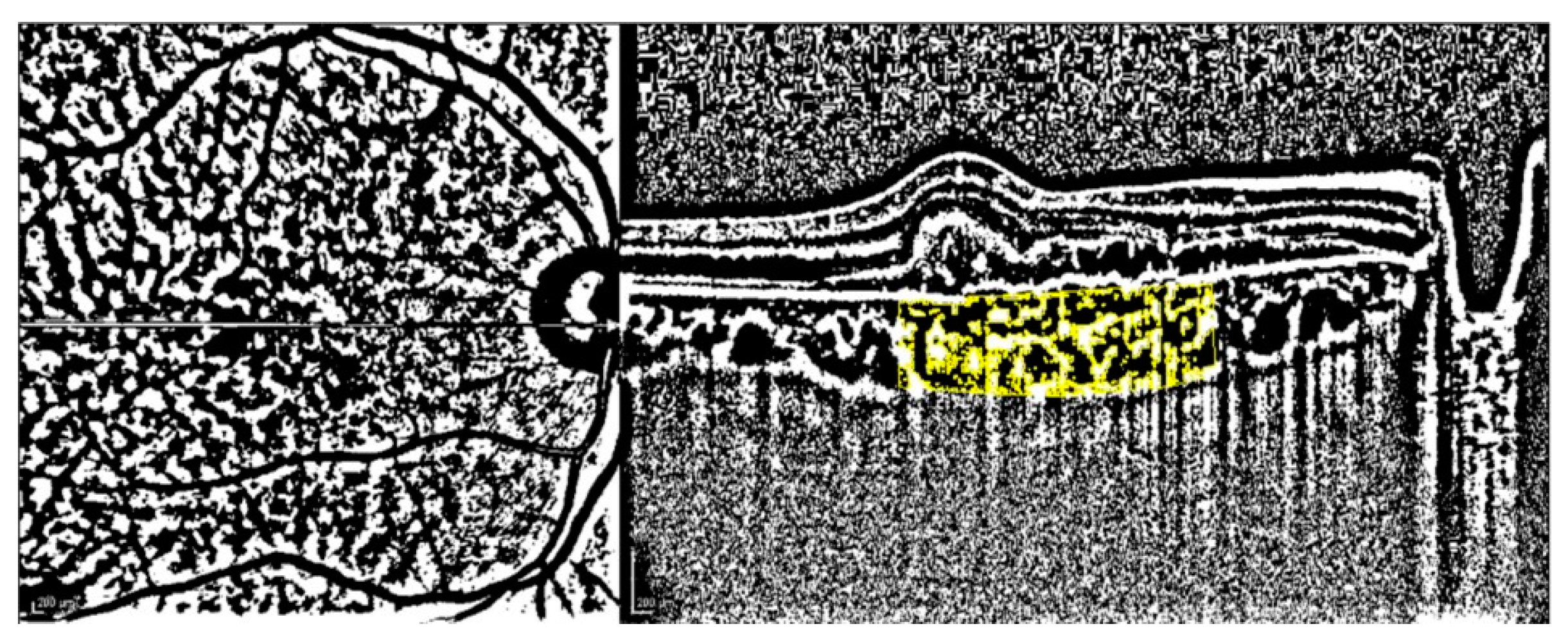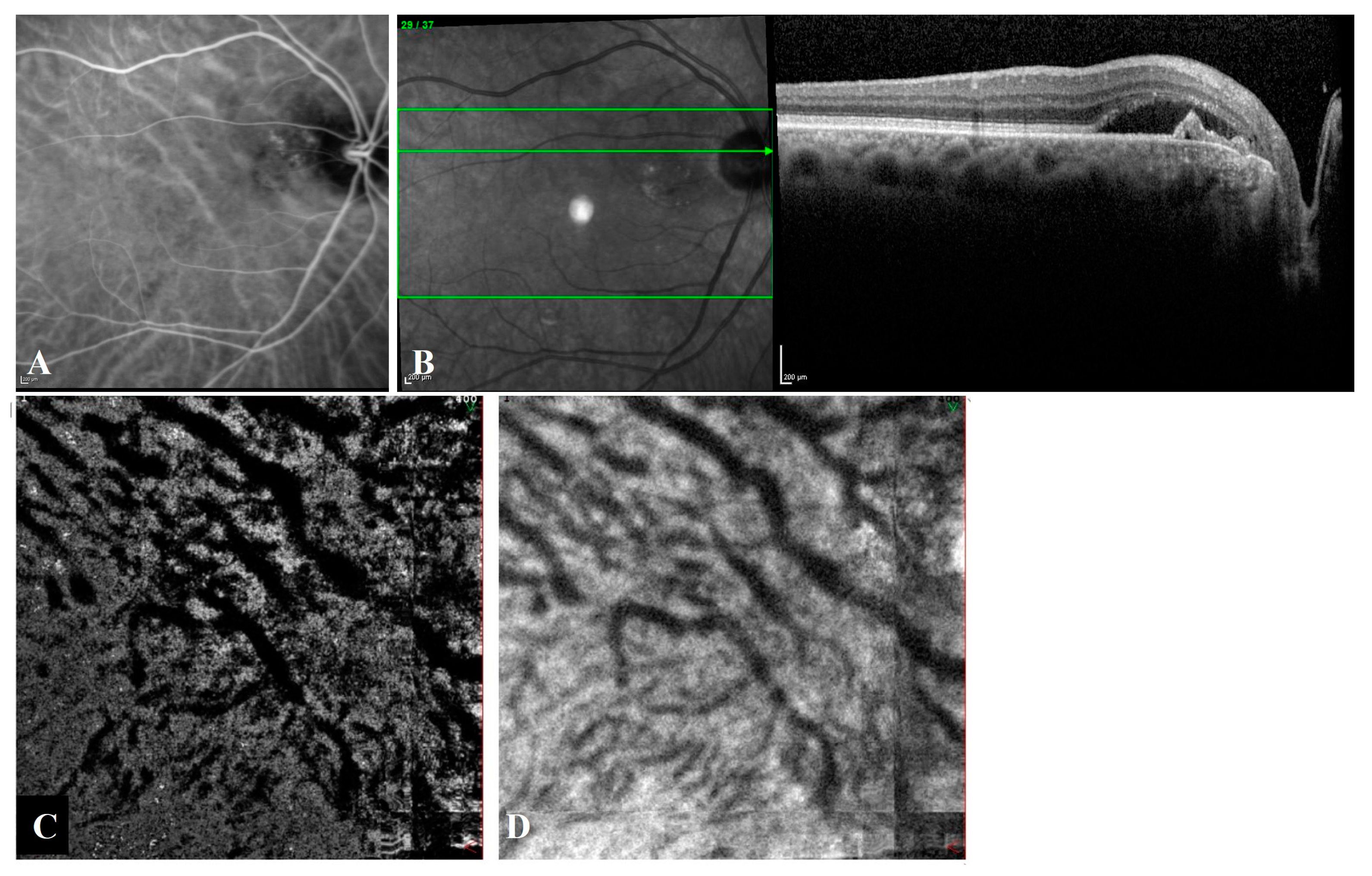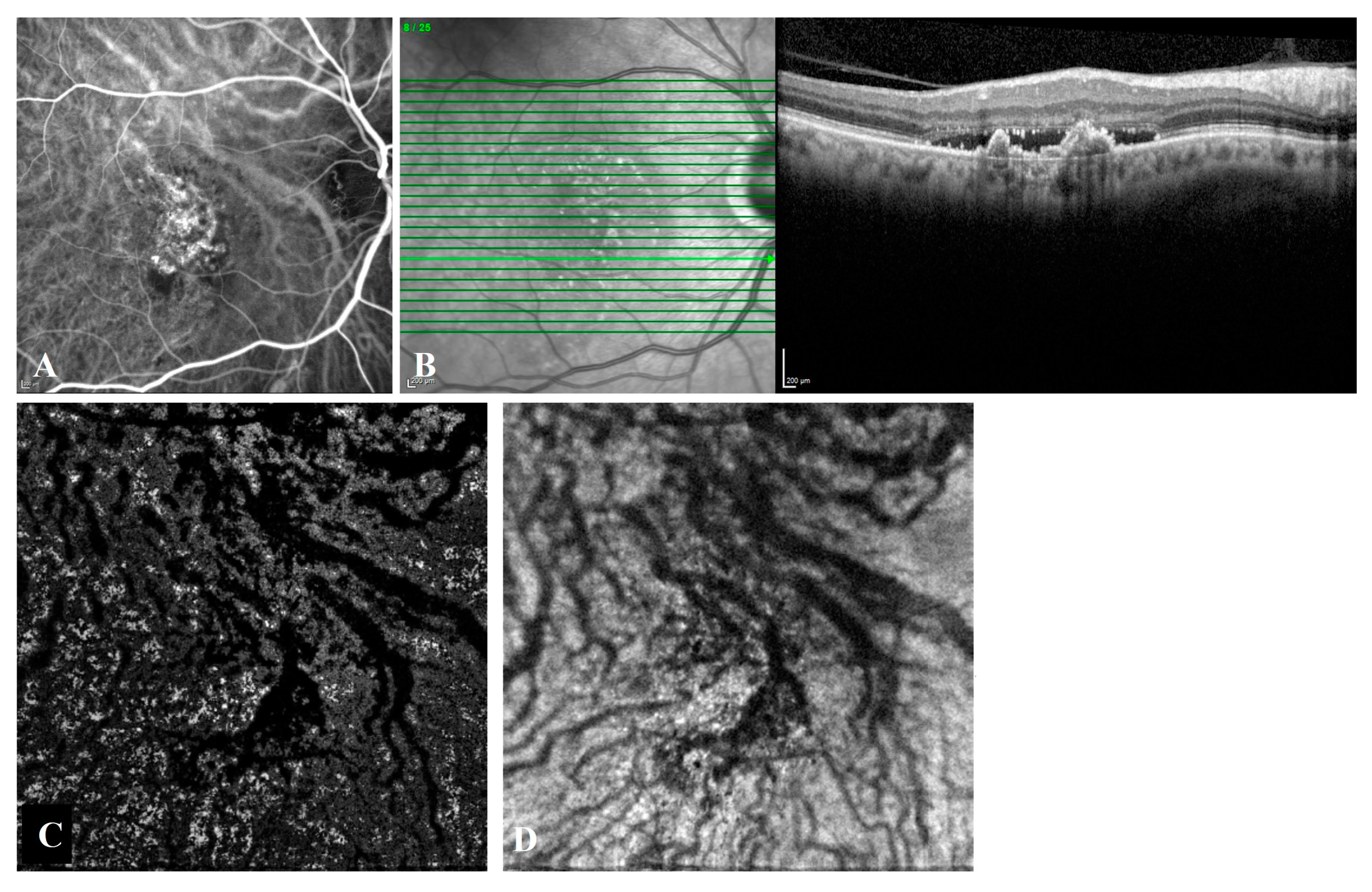A Comparative Study of Choroidal Vascular and Structural Characteristics of Typical Polypoidal Choroidal Vasculopathy and Polypoidal Choroidal Neovascularization: OCTA-Based Evaluation of Intervortex Venous Anastomosis
Abstract
1. Introduction
2. Materials and Methods
2.1. Patient Selection
2.2. Choroidal Binarization
2.3. Statistical Analysis
3. Results
4. Discussion
5. Conclusions
Author Contributions
Funding
Institutional Review Board Statement
Informed Consent Statement
Data Availability Statement
Conflicts of Interest
References
- Yannuzzi, L.A.; Sorenson, J.; Spaide, R.F.; Lipson, B. Idiopathic polypoidal choroidal vasculopathy (IPCV). Retina 1990, 10, 1–8. [Google Scholar]
- Lee, W.K.; Baek, J.; Dansingani, K.K.; Lee, J.H.; Freund, K.B. Choroidal Morphology in Eyes with Polypoidal Choroidal Vasculopathy and Normal or Subnormal Subfoveal Choroidal Thickness. Retina 2016, 36 (Suppl. S1), S73–S82. [Google Scholar] [CrossRef]
- Spaide, R.F.; Ledesma-Gil, G.; Gemmy Cheung, C.M. Intervortex venous anastomosis in pachychoroid-related disorders. Retina 2021, 41, 997–1004. [Google Scholar] [CrossRef]
- Sharma, A.; Parachuri, N.; Kumar, N.; Bandello, F.; Kuppermann, B.D.; Loewenstein, A.; Regillo, C.D.; Chakravarthy, U. Vortex vein anastomosis and pachychoroid-an evolving understanding. Eye 2021, 35, 1545–1547. [Google Scholar] [CrossRef]
- Matsumoto, H.; Hoshino, J.; Mukai, R.; Nakamura, K.; Kikuchi, Y.; Kishi, S.; Akiyama, H. Vortex Vein Anastomosis at the Watershed in Pachychoroid Spectrum Diseases. Ophthalmol. Retin. 2020, 4, 938–945. [Google Scholar] [CrossRef]
- Jang, J.W.; Kim, J.M.; Kang, S.W.; Kim, S.J.; Bae, K.; Kim, K.T. Typical Polypoidal Choroidal Vasculopathy and Polypoidal Choroidal Neovascularization. Retina 2019, 39, 1995–2003. [Google Scholar] [CrossRef]
- Inoue, M.; Balaratnasingam, C.; Freund, K.B. Optical Coherence Tomography Angiography of Polypoidal Choroidal Vasculopathy and Polypoidal Choroidal Neovascularization. Retina 2015, 35, 2265–2274. [Google Scholar] [CrossRef]
- Yeung, L.; Kuo, C.N.; Chao, A.N.; Chen, K.J.; Wu, W.C.; Lai, C.H.; Wang, N.K.; Hwang, Y.S.; Chen, C.L.; Lai, C.C. Angiographic subtypes of polypoidal choroidal vasculopathy in Taiwan: A Prospective Multicenter Study. Retina 2018, 38, 263–271. [Google Scholar] [CrossRef]
- Yuzawa, M.; Mori, R.; Kawamura, A. The origins of polypoidal choroidal vasculopathy. Br. J. Ophthalmol. 2005, 89, 602–607. [Google Scholar] [CrossRef]
- Honda, S.; Miki, A.; Yanagisawa, S.; Matsumiya, W.; Nagai, T.; Tsukahara, Y. Comparison of the outcomes of photodynamic therapy between two angiographic subtypes of polypoidal choroidal vasculopathy. Ophthalmologica 2014, 232, 92–96. [Google Scholar] [CrossRef]
- Coscas, G.; Lupidi, M.; Coscas, F.; Benjelloun, F.; Zerbib, J.; Dirani, A.; Semoun, O.; Souied, E.H. Toward a specific classification of polypoidal choroidal vasculopathy: Idiopathic disease or subtype of age-related macular degeneration. Investig. Ophthalmol. Vis. Sci. 2015, 56, 3187–3195. [Google Scholar] [CrossRef]
- Kawamura, A.; Yuzawa, M.; Mori, R.; Haruyama, M.; Tanaka, K. Indocyanine green angiographic and optical coherence tomographic findings support classification of polypoidal choroidal vasculopathy into two types. Acta Ophthalmol. 2013, 91, e474–e481. [Google Scholar] [CrossRef]
- Tanaka, K.; Mori, R.; Kawamura, A.; Nakashizuka, H.; Wakatsuki, Y.; Yuzawa, M. Comparison of OCT angiography and indocyanine green angiographic findings with subtypes of polypoidal choroidal vasculopathy. Br. J. Ophthalmol. 2017, 101, 51–55. [Google Scholar] [CrossRef]
- Agrawal, R.; Chhablani, J.; Tan, K.A.; Shah, S.; Sarvaiya, C.; Banker, A. Choroidal Vascularity Index in Central Serous Chorioretinopathy. Retina 2016, 36, 1646–1651. [Google Scholar] [CrossRef]
- Tan, K.A.; Agrawal, R. Luminal and Stromal Areas of Choroid Determined by Binarization Method of Optical Coherence Tomographic Images. Am. J. Ophthalmol. 2015, 160, 394. [Google Scholar] [CrossRef]
- Liu, B.; Zhang, X.; Mi, L.; Peng, Y.; Wen, F. Choroidal structure in subtypes of polypoidal choroidal vasculopathy determined by binarization of optical coherence tomographic images. Clin. Exp. Ophthalmol. 2019, 47, 631–637. [Google Scholar] [CrossRef]
- Ting, D.S.W.; Yanagi, Y.; Agrawal, R.; Teo, H.Y.; Seen, S.; Yeo, I.Y.S.; Mathur, R.; Chan, C.M.; Lee, S.Y.; Wong, E.Y.M.; et al. Choroidal Remodeling in Age-related Macular Degeneration and Polypoidal Choroidal Vasculopathy: A 12-month Prospective Study. Sci. Rep. 2017, 7, 7868. [Google Scholar] [CrossRef]
- Bakthavatsalam, M.; Ng, D.S.; Lai, F.H.; Tang, F.Y.; Brelen, M.E.; Tsang, C.W.; Lai, T.Y.; Cheung, C.Y. Choroidal structures in polypoidal choroidal vasculopathy, neovascular age-related maculopathy, and healthy eyes determined by binarization of swept source optical coherence tomographic images. Graefes Arch. Clin. Exp. Ophthalmol. 2017, 255, 935–943. [Google Scholar] [CrossRef]
- Lee, K.; Park, J.H.; Park, Y.G.; Park, Y.H. Analysis of choroidal thickness and vascularity in patients with unilateral polypoidal choroidal vasculopathy. Graefes Arch. Clin. Exp. Ophthalmol. 2020, 258, 1157–1164. [Google Scholar] [CrossRef]
- Gupta, P.; Ting, D.S.W.; Thakku, S.G.; Wong, T.Y.; Cheng, C.Y.; Wong, E.; Mathur, R.; Wong, D.; Yeo, I.; Gemmy Cheung, C.M. Detailed Characterization of Choroidal Morphologic and Vascular Features in Age-Related Macular Degeneration and Polypoidal Choroidal Vasculopathy. Retina 2017, 37, 2269–2280. [Google Scholar] [CrossRef]
- Matsumoto, H.; Kishi, S.; Mukai, R.; Akiyama, H. Remodeling of macular vortex veins in pachychoroid neovasculopathy. Sci. Rep. 2019, 9, 14689. [Google Scholar] [CrossRef]
- Chung, S.E.; Kang, S.W.; Kim, J.H.; Kim, Y.T.; Park, D.Y. Engorgement of vortex vein and polypoidal choroidal vasculopathy. Retina 2013, 33, 834–840. [Google Scholar] [CrossRef]
- Jeong, S.; Sagong, M. Short-term efficacy of intravitreal aflibercept depending on angiographic classification of polypoidal choroidal vasculopathy. Br. J. Ophthalmol. 2017, 101, 758–763. [Google Scholar] [CrossRef]
- McHugh, M.L. Interrater reliability: The kappa statistic. Biochem. Med. 2012, 22, 276–282. [Google Scholar]
- Dansingani, K.K.; Gal-Or, O.; Sadda, S.R.; Yannuzzi, L.A.; Freund, K.B. Understanding aneurysmal type 1 neovascularization (polypoidal choroidal vasculopathy): A lesson in the taxonomy of ‘expanded spectra’—A review. Clin. Exp. Ophthalmol. 2018, 46, 189–200. [Google Scholar] [CrossRef]
- Chang, Y.C.; Cheng, C.K. Difference between Pachychoroid and Nonpachychoroid Polypoidal Choroidal Vasculopathy and Their Response to Anti-Vascular Endothelial Growth Factor Therapy. Retina 2020, 40, 1403–1411. [Google Scholar] [CrossRef]
- Tan, C.S.; Lim, L.W.; Ngo, W.K.; Lim, T.H.; Group, E.S. EVEREST Report 5: Clinical Outcomes and Treatment Response of Polypoidal Choroidal Vasculopathy Subtypes in a Multicenter, Randomized Controlled Trial. Invest. Ophthalmol. Vis. Sci. 2018, 59, 889–896. [Google Scholar] [CrossRef]
- Byeon, S.H.; Lee, S.C.; Oh, H.S.; Kim, S.S.; Koh, H.J.; Kwon, O.W. Incidence and clinical patterns of polypoidal choroidal vasculopathy in Korean patients. Jpn. J. Ophthalmol. 2008, 52, 57–62. [Google Scholar] [CrossRef]
- Cackett, P.; Wong, D.; Yeo, I. A classification system for polypoidal choroidal vasculopathy. Retina 2009, 29, 187–191. [Google Scholar] [CrossRef]
- Liu, Z.Y.; Li, B.; Xia, S.; Chen, Y.X. Analysis of choroidal morphology and comparison of imaging findings of subtypes of polypoidal choroidal vasculopathy: A new classification system. Int. J. Ophthalmol. 2020, 13, 731–736. [Google Scholar] [CrossRef]
- Matsumoto, H.; Hoshino, J.; Arai, Y.; Mukai, R.; Nakamura, K.; Kikuchi, Y.; Kishi, S.; Akiyama, H. Quantitative measures of vortex veins in the posterior pole in eyes with pachychoroid spectrum diseases. Sci. Rep. 2020, 10, 19505. [Google Scholar] [CrossRef]
- Jeong, A.; Lim, J.; Sagong, M. Choroidal Vascular Abnormalities by Ultra-widefield Indocyanine Green Angiography in Polypoidal Choroidal Vasculopathy. Invest. Ophthalmol. Vis. Sci. 2021, 62, 29. [Google Scholar] [CrossRef]




| T-PCV (n = 23 Eyes) | P-CNV (n = 12 Eyes) | p Value | |
|---|---|---|---|
| Mean ± SD | Mean ± SD | ||
| Age, years | 67.5 ± 8.9 | 66.1 ± 7.8 | 0.655 a |
| BCVA, LogMAR | 0.25 ± 0.30 | 0.42 ± 0.29 | 0.049a |
| Choroidal measurements | |||
| 356.0 ± 168.0 | 267.8 ± 68.7 | 0.036b |
| 0.872 ± 0.392 | 0.708 ± 0.163 | 0.092 b |
| 0.647 ± 0.301 | 0.502 ± 0.122 | 0.052 b |
| 0.225 ± 0.096 | 0.206 ± 0.055 | 0.532 b |
| 73.9 ± 3.7 | 70.8 ± 4.5 | 0.039b |
| Indocyanine green angiography characteristics | |||
| 4.917 ± 3.226 | 6.131 ± 5.946 | 0.797 a |
| Optical coherence tomography angiography characteristics, n = 33 | |||
| 85.7 (18/21) | 91.7 (11/12) | 1.000 c |
Disclaimer/Publisher’s Note: The statements, opinions and data contained in all publications are solely those of the individual author(s) and contributor(s) and not of MDPI and/or the editor(s). MDPI and/or the editor(s) disclaim responsibility for any injury to people or property resulting from any ideas, methods, instructions or products referred to in the content. |
© 2022 by the authors. Licensee MDPI, Basel, Switzerland. This article is an open access article distributed under the terms and conditions of the Creative Commons Attribution (CC BY) license (https://creativecommons.org/licenses/by/4.0/).
Share and Cite
Batıoğlu, F.; Yanık, Ö.; Özer, F.; Demirel, S.; Özmert, E. A Comparative Study of Choroidal Vascular and Structural Characteristics of Typical Polypoidal Choroidal Vasculopathy and Polypoidal Choroidal Neovascularization: OCTA-Based Evaluation of Intervortex Venous Anastomosis. Diagnostics 2023, 13, 138. https://doi.org/10.3390/diagnostics13010138
Batıoğlu F, Yanık Ö, Özer F, Demirel S, Özmert E. A Comparative Study of Choroidal Vascular and Structural Characteristics of Typical Polypoidal Choroidal Vasculopathy and Polypoidal Choroidal Neovascularization: OCTA-Based Evaluation of Intervortex Venous Anastomosis. Diagnostics. 2023; 13(1):138. https://doi.org/10.3390/diagnostics13010138
Chicago/Turabian StyleBatıoğlu, Figen, Özge Yanık, Ferhad Özer, Sibel Demirel, and Emin Özmert. 2023. "A Comparative Study of Choroidal Vascular and Structural Characteristics of Typical Polypoidal Choroidal Vasculopathy and Polypoidal Choroidal Neovascularization: OCTA-Based Evaluation of Intervortex Venous Anastomosis" Diagnostics 13, no. 1: 138. https://doi.org/10.3390/diagnostics13010138
APA StyleBatıoğlu, F., Yanık, Ö., Özer, F., Demirel, S., & Özmert, E. (2023). A Comparative Study of Choroidal Vascular and Structural Characteristics of Typical Polypoidal Choroidal Vasculopathy and Polypoidal Choroidal Neovascularization: OCTA-Based Evaluation of Intervortex Venous Anastomosis. Diagnostics, 13(1), 138. https://doi.org/10.3390/diagnostics13010138







